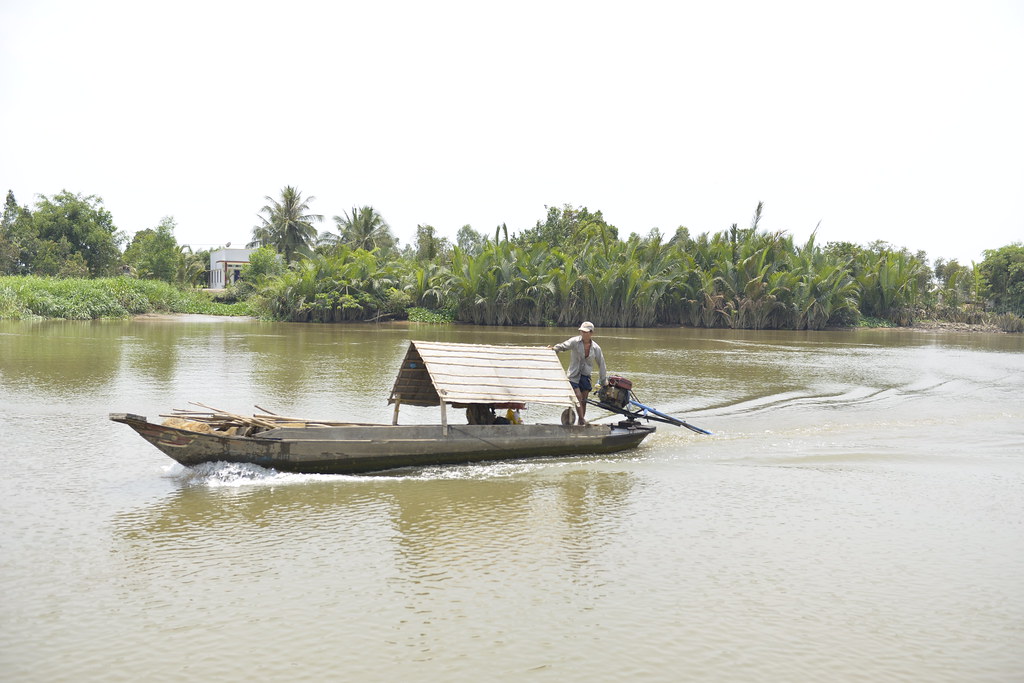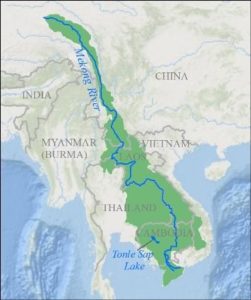 AA Stivers, USAID Vietnam, 2015
AA Stivers, USAID Vietnam, 2015
Upstream Hydroelectricity, Downstream Difficulty: Resource Politics in the Mekong River Basin
The Mekong River system is a complex waterbody traversing Southeast Asia. Home to the world’s third most diverse fish population, the Mekong sustains over one thousand marine species spanning six countries. The river is as biodiverse as it is politically convoluted, particularly where the problem of dam infrastructure is concerned. Damming the Mekong River has been wrought with complicated climate externalities, in addition to destabilizing regional politics and upsetting local subsistence fisheries.

Lower Mekong River Basin Map, US Geological Survey, 2019
Dam projects along the Mekong River have posited infrastructure to contain flood cycles, secured sustainable energy supplies, and produced reliable irrigation techniques necessary to meet the demands of steady regional population growth. It is estimated that the river can generate over 30,000 megawatts of electricity in the region and draw huge foreign direct investment into the energy sector. Such projections are encouraging in the transition toward cleaner and more diverse energy initiatives, particularly where Thailand’s total energy consmptuion is 80 percent fossil fuel reliant. Over 60 million people rely on the river’s provisions for survival. Closely tied to the health of the river’s streamflow are the inland captured fisheries of the Lower Mekong Basin, the largest of its kind and yielding an estimated 2.3 million tons of freshwater fish catch and 11 billion US dollars in revenue every year.
Despite the real benefits of dam implementation for irrigation and energy sectors, these projects also present detrimental ecosystem issues in disrupting fish migratory patterns, trapping riverbed sediment within each river segment, and impeding the streamflow essential to thriving freshwater habitats. It is crucial that these externalities are effectively mitigated and incorporated into regional planning schematics to justify the implementation of hydroelectric energy supply in regions critically reliant on both stable energy supplies and ecological resources sustained by uninhibited river streamflow. Climate resiliency strategy is especially crucial where the Mekong River System has experienced three consecutive years of below-average rainfall.
Another casualty of dam infrastructure changes are the subsistence fisheries along the river and its tributaries. Dam infrastructure regulates the Mekong’s streamflow, a practice which complicates the migratory patterns of fish who formerly traversed where the dam turbines now operate. Current projections suggest that with the construction of eleven new mainstream dams by 2030, fisheries production could decrease by 900,000 tons per year. Hydropower development projects frequently impede access to the river for subsistence fishermen relying on the Mekong for economic and nutritive sustenance. Left unaddressed, significant reductions in fishery production could exacerbate already high levels of nutrient insecurity in rural regions. Some models forecast that by 2030, Lower Mekong Basin states like Cambodia could face a total population of over 2 million people with increased risks of nutritional protein deficiencies. The prosperity of upstream nations in harnessing the Mekong’s hydroelectric power comes at the expense of the downstream rural populations with close dietary and economic ties to the river’s natural flow.
The Cambodian lake Tonle Sap, for example, is the largest freshwater body of its kind in southeast Asia and serves as a biodiverse marine haven for hundreds of fish species and marine organisms. Affectionally referred to as “the heart of the Mekong,” the Tonle Sap floodplain supports more than 3 million people and boasts one of the world’s most productive freshwater fishery operations. local fishermen and community leaders are increasingly concerned as upstream dams and reservoirs cripple stream flow in the Tonle Sap to record lows. Upstream damming has made the water uncharacteristically blue, just one undesirable complication of trapped sediments behind dam infrastructure crucial to heathy riverbanks and enriched floodplain soil. Fish populations are stretched and the nutritive and economic security in surrounding local communities is waning. Compounded by the effects of climate-related changes and the presence of black-market fisheries on the river engaged in illicit fishing activity, fish prices in local markets are skyrocketing as precious basin resources are increasingly scarce. Experts plead for increased inter-basin communication on the impacts of dam operations on the Tonle Sap and other vital regional tributaries—historically, however, this cooperation has been easier said than done.
Interstate river basins such as the Mekong historically instigate tense water and resource related disputes as downstream users initiate restitution requests for upstream dam externalities and water overconsumption. As climate change continues to threaten the sustainability of the Mekong, political tensions in the region will escalate. As the dominant upstream user within the Mekong River System, China’s 11 dam projects currently hold back more than 12 trillion gallons of water to the detriment of downstream users and fish habitats. This dynamic is increasingly alarming in times of drought and impending climate change pressures, when China effectively controls the river’s flow through its extensive hydroelectric infrastructure system. As drought becomes more frequent, the net value of the fisheries sector in the lower Mekong countries of Cambodia, Laos, Thailand and Vietnam could decline by 22.6 million US dollars by 2040. Such a dense concentration of power in one basin state could decimate downstream commercial industry and devastate rural populations in already impoverished nations sharing portions of the Mekong’s provisions. Economies built on raw resource extraction like the communities along the Mekong’s banks bear the external costs of hydroelectric dam developments that governments are unlikely to repay.
The financial outlook of some projects are additionally bleak in the operational phase. Many dam projects are originally born out of public-private partnerships to facilitate construction and early dam management at a reasonable cost. Preceding a fixed period of private operation, corporations assign the dam back to the national government for oversight—by this time, dam infrastructure can be overrun by an unmanageable level of sediment that sometimes renders the project altogether inoperable. In these cases, national governments are left to bear these renovation costs accompanying privately-operated dam projects. Because hydroelectric energy ventures are historically highly subsidized to ensure energy is affordable for consumers, Mekong Basin governments cannot justify hydroelectric projects that encounter exorbitant fiscal complications.
The Mekong-U.S. Partnership serves as the linchpin of United States foreign policy in the Mekong region. Among other strategic efforts, the partnership aims to align with ASEAN regional outlooks, foster sustainable development practices, and provide necessary infrastructure and energy investment to lower basin states. Since 2009, the United States has spent nearly $120 million on its Lower Mekong Initiative to strengthen water management, improve health systems, and support education in Mekong communities. In recent years, U.S. involvement has been fueled by China’s increased upstream water consumption and development of the Lancang Mekong Cooperation, a cooperation many believe is intended to rival the existing coalition of basin states, the Mekong River Commission. In this contentious battle of diplomatic watershed alliances, the prevailing governing body will control the direction of scientific findings and environmental policy which affect future development along the river.
Thankfully, the Mekong River Basin can learn from these oversights. The Association of Southeast Asian Nations (ASEAN) is working hard to diversify economic opportunity, forage relationships with other regional entities, and facilitate targeted initiatives to remedy ecological damages. Environmental impact assessments of hydroelectric power feasibility, regional demand projections, and the economic value of fishing and other in-stream uses have become common practice for the Mekong River Commission. Implementing monitoring programs of a given dam project’s downstream economic and environmental effects are also crucial to crafting intelligent technical guidelines for basin-wide ecological management protocol. Fish passages and sediments gates are viable mechanisms to mitigate disastrous ecological impacts. The Mekong River is a powerful, resilient force of nature sustaining Southeastern Asia’s populations for centuries—adaptations to a changing climate and growing population are critical to the system’s survival and stable diplomatic relations among Southeastern Asian nations.





